The less than flattering term “grunge” dates back to at least 1981, when a young high school student named Mark McLaughlin was describing his band, Mr. Epp and the Calculations, in the now-defunct Desperate Times magazine. The man who would later replace his surname McLaughlin with the edgier Arm referred to his band as “pure grunge, pure noise, pure shit.” Six years later, Sub Pop Records co-founder Bruce Pavitt would describe Arm’s band, which included two future members of Pearl Jam, Green River’s “Dry as a Bone” EP as “ultra-loose grunge that destroyed the morals of a generation.” That same year, Sub Pop would release Soundgarden’s raw debut EP, “Screaming Life”. By the time they released Nirvana’s debut album, “Bleach,” in 1989, Soundgarden was signed to A&M, and the major labels had figured out that there was something going on in Seattle besides Starbucks and rainy days. In a nutshell, this is how grunge as we know it came to take over Seattle.

The Ultimate Grunge Guide to Seattle
Many boast the “grunge is dead” mantra loudly, but you can still see many of the spots that put these bands on the map around town. This is a list of places that grunge fans can still visit around town, arranged in chronological order as much as possible. Included are obvious places like MoPOP and the former Cobain residence, but you can also visit the hotels, parks, record stores, concert venues, and more that require the type of deep digging that Eddie Vedder accused the music industry of failing to do in the 1996 film, “Hype!”
The rise and fall of an iconic Seattle sound
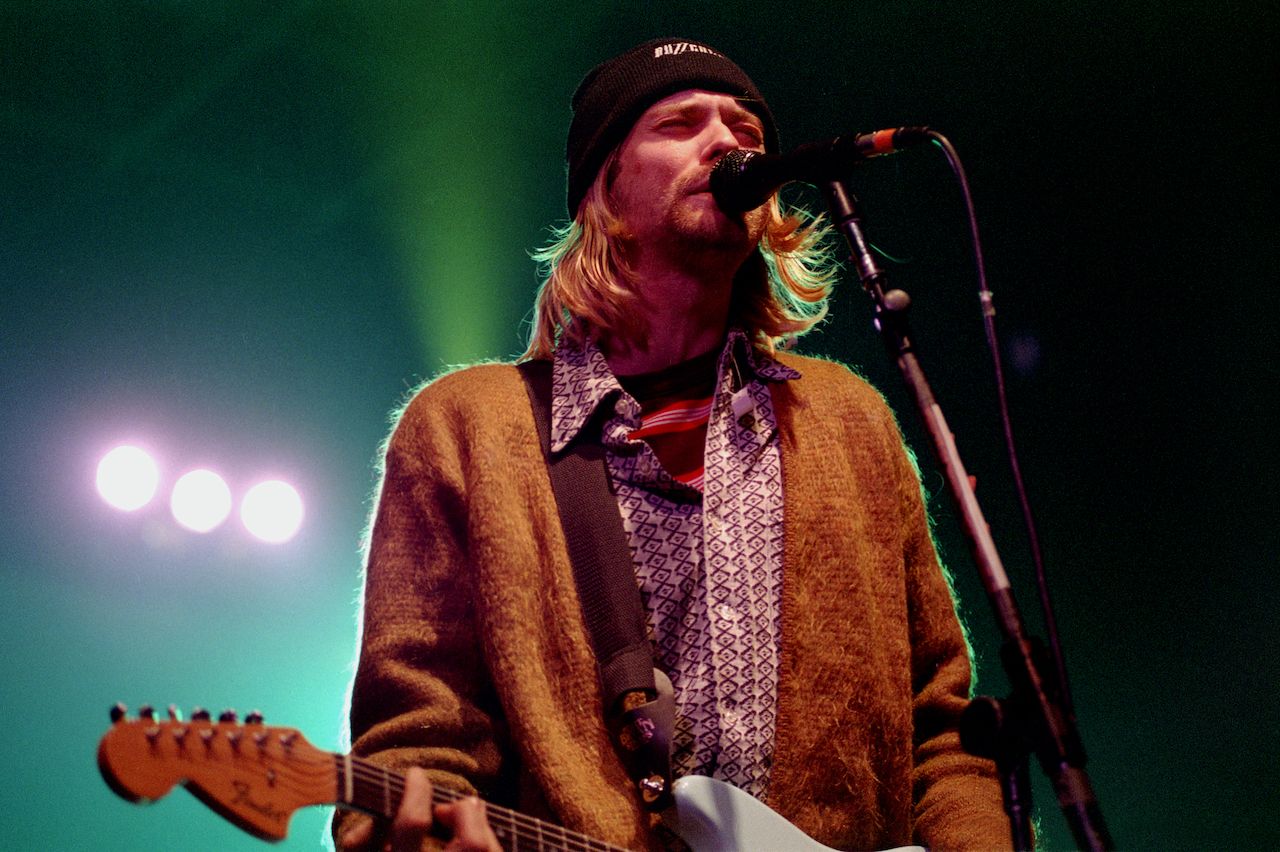
Photo: Fabio Diena/Shutterstock
By August of 1991, all four of the grunge bands most commonly referred to as the “big four” were signed to major labels. Nirvana signed to Geffen while Alice in Chains and Pearl Jam released their debut albums on Columbia and Epic. None of those bands were fond of the word grunge, though there was a general camaraderie among the members, save for Kurt Cobain’s verbal attacks on Pearl Jam.
In January of 1992, Nirvana’s “Nevermind” knocked Michael Jackson from the number one spot on the Billboard 200. The big four would release a combined six more number one albums by 1996. By the following year, Pearl Jam was the only band still going, and to this day, they remain the only of the original big four still relatively intact — with four of the five original members. The scene fell from the mainstream as fast as it rose, due in large part to the 1994 suicide of Kurt Cobain followed by Layne Staley’s heroin-fueled hiatus, which started in 1996, and Soundgarden’s 14-year hiatius, which began the following year. Seattle has moved on, but for many music fans, Seattle history starts with the founding of Sub Pop and ends with “Down on the Upside.” Despite how locals may feel about the overexposure of a handful of bands that brought the “Seattle sound” to the mainstream, the city has done an amazing job of preserving this history for fans.
1. Terminal Sales Building
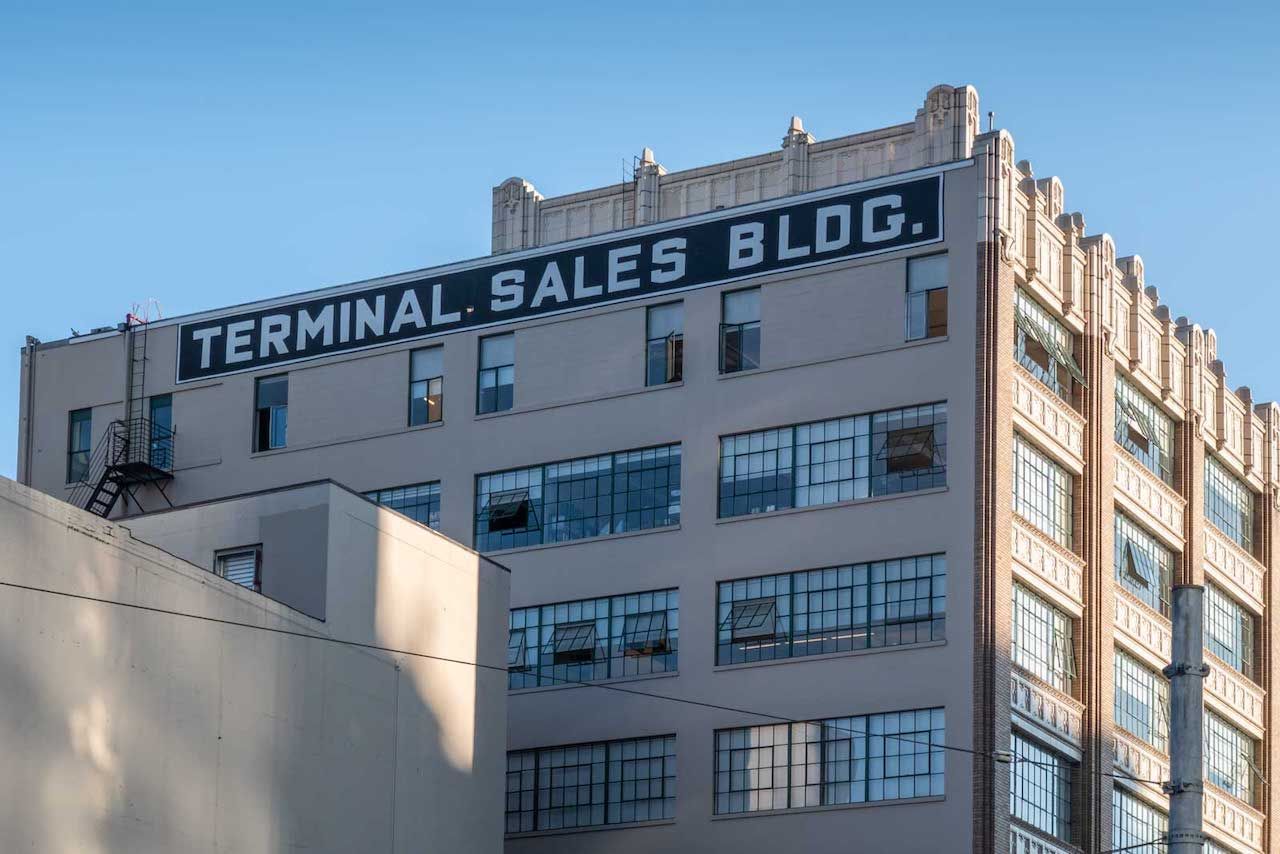
Photo: Brian Cicioni
In early April of 1988, the label that introduced the world to Mudhoney, Nirvana, and Soundgarden moved into its 11th-floor office in Seattle’s Terminal Sales Building. That same year, Sub Pop co-founder Bruce Pavitt assured Chris Cornell, “Seattle’s gonna take over the world.” Sub Pop has gone on to outlive Nirvana, Soundgarden, and even its founders, with the “Going Out of Business Since 1988” motto remaining to this day. Back then, most (including one of the frontmen who would help make that happen just four years later) would have brushed him off as overly ambitious. To this day, the elevator only goes up to the 10th floor of the Terminal Sales Building. You have to walk up from there. The current “world headquarters” is just four blocks from the Terminal Sales Building.
Where: 1932 1st Ave.
Nearest light rail station: Westlake
2. A Sound Garden

Photo: Brian Cicioni
The first of the Seattle grunge bands to sign to a major label, Soundgarden took its name from this outdoor public artwork located on the National Oceanic and Atmospheric Administration (NOAA) campus. The sculptural group of a dozen 21-foot high steel towers makes un-grunge-like soothing sounds when the wind passes through. This is because each one is topped with an organ pipe attached to a weather vane. Bring your imagination and visit during a windy day, and maybe you’ll hear the intro to “The Day I Tried to Live” or “Beyond the Wheel.” Either way, the setting along the northwest shore of Lake Washington can be a serene escape from gridlock traffic and the seemingly never-ending luxury condos that seem to be sprouting up everywhere near the downtown area.
Where: 7600 Sand Point Way
3. Central Saloon
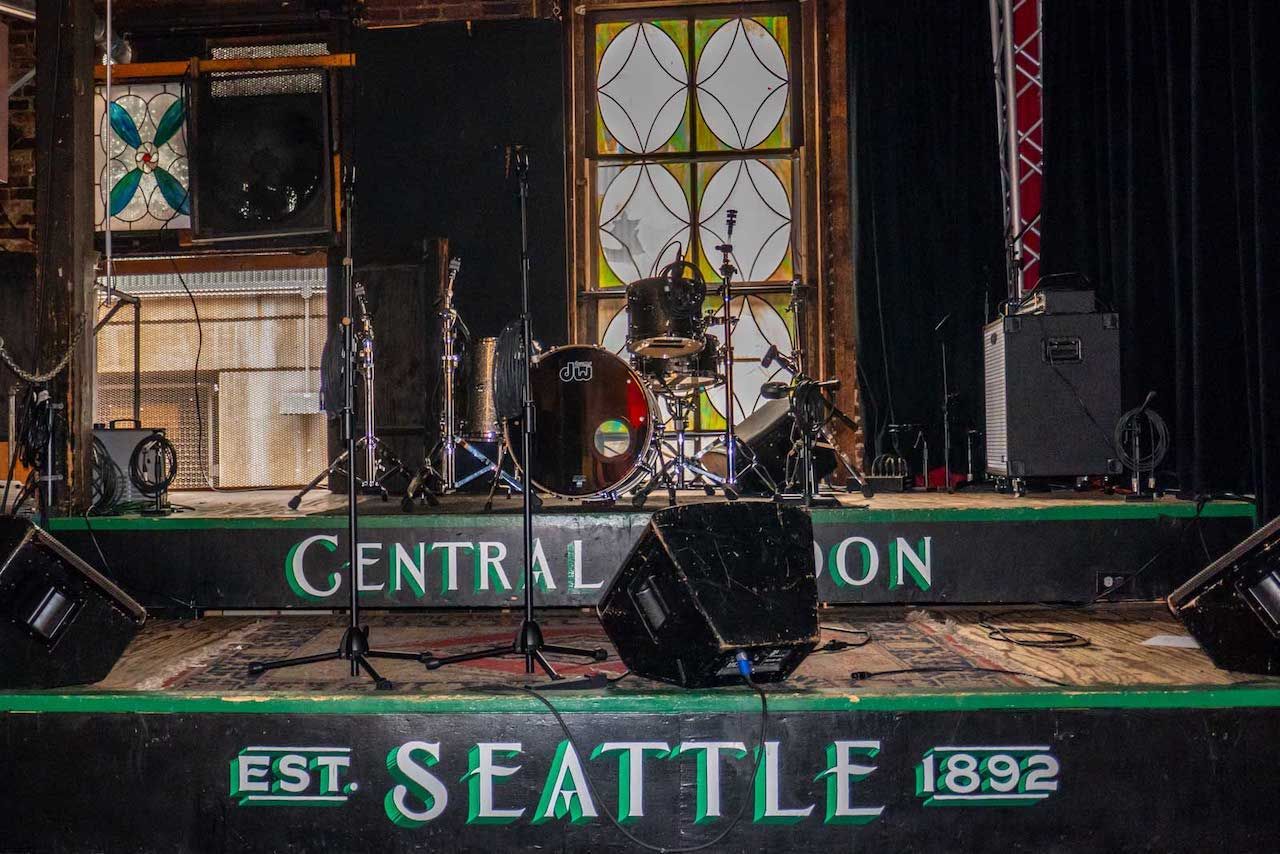
Photo: Brian Cicioni
One of the last grand old saloons, The Central dates back to the 1890s, opened just three years after the great fire. Before Alice in Chains, Nirvana, and Soundgarden headlined arenas and festivals around the world, they all played at the Central. The venue is similar in size to the former CBGB and still hosts bands. The walls are lined with photos and concert flyers from the days, which led up to the brief period when Seattle seemed like the center of the musical universe.
Where: 207 1st Ave South
Nearest light rail station: Pioneer Square
4. El Corazon (the former Off Ramp Cafe)
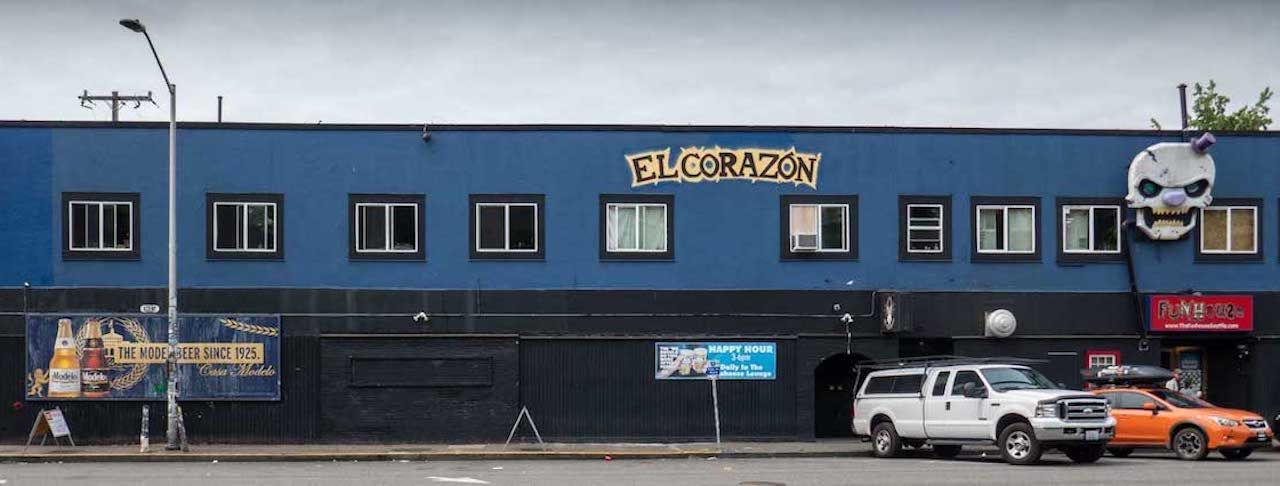
Photo: Brian Cicioni
On October 22, 1990, Mookie Blaylock played its first show at the Off Ramp Cafe. The following year, the band opened for Alice in Chains on its “Facelift” tour, signed a deal with Epic Records, renamed itself Pearl Jam, and released its debut album, “Ten,” in honor of Blaylock’s basketball jersey. The building is still there, but it’s been renamed El Corazon. If you search for it on Google Maps and find Funhouse, it’s the same building.
Where: 109 Eastlake Ave.
Nearest light rail station: Westlake
5. Re-bar

Photo: Brian Cicioni
Re-bar opened in 1990, just as Seattle bands like Nirvana and Soundgarden were gaining national recognition. Steve and Linda meet here in the movie “Singles.” On September 13, 1991, Friday the 13th, Re-bar hosted the release party for Nirvana’s second studio album and major label debut, “Nevermind.” After the band members started an alcohol-infused food fight, they were kicked out of their own record release party. “Nevermind” would go on to sell more than 10 million copies in the US and 30 million worldwide. Courtesy of Jeff Ament, you can now see a replica of the Mother Love Bone mural (featured in Singles) on the wall outside Easy Street Records in West Seattle. Despite all the post-2000 changes in Seattle, the venue is still going strong today.
Where: 1114 Howell St.
Nearest light rail station: Westlake
6. The Paramount

Photo: Brian Cicioni
The Paramount has been on the National Register of Historic Places since 1974, in part because local bands like Heart, Nirvana, and Soundgarden recorded concert films at the venue. Nirvana played here on Halloween 1991, just five weeks after the release of “Nevermind.” They opened with an electric version of The Vaselines “Jesus Doesn’t Want Me For a Sunbeam” and also played the then-unreleased “Rape Me.” The show was officially released 20 years later as “Live at the Paramount.” Soundgarden’s March 6, 1992, Paramount show was released in its entirety under the same name as part of the 25th-anniversary re-release of “Badmotorfinger.”
Where: 911 Pine St.
Nearest light rail station: Westlake
7. The West Point Lighthouse
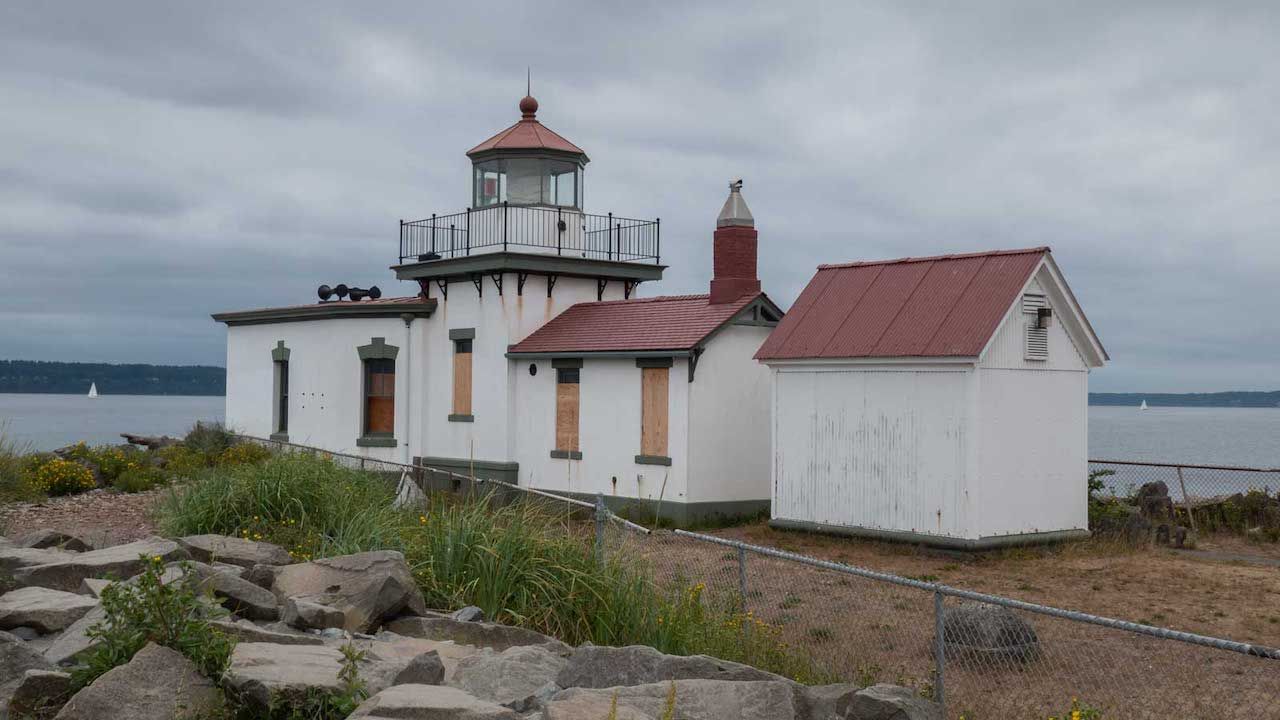
Photo: Brian Cicioni
This is the lighthouse you see in Temple of the Dog’s “Hunger Strike” video. Just months before Chris Cornell broke his Rusty Cage, and Eddie Vedder let the world know that he’s still alive, Temple of the Dog released its only album. It started as a tribute to Mother Love Bone (Jeff Ament and Stone Gossard’s pre-Pearl Jam band) frontman, Andrew Wood. The project started with two songs, “Say Hello 2 Heaven” and “Reach Down,” and eventually was released as an album featuring Chris Cornell and the Pearl Jam lineup from 1998 to the present. Both the lighthouse and the beach they perform on are part of Discovery Park, which is situated on the Puget Sound.
Where: 3801 Discovery Park Blvd.
8. The Former Cobain Residence

Photo: Brian Cicioni
The house Kurt Cobain spent his final days in is located along Lake Washington Blvd. in an exclusive neighborhood, just one block west of the lake. The house is hidden behind several tall trees. A tall wooden gate prevents entry to the property. Fans still get their pictures taken in front of the gate, although the house has not been in the Cobain family since at least 2003.
Where: 171 Lake Washington Blvd. East
9. Viretta Park
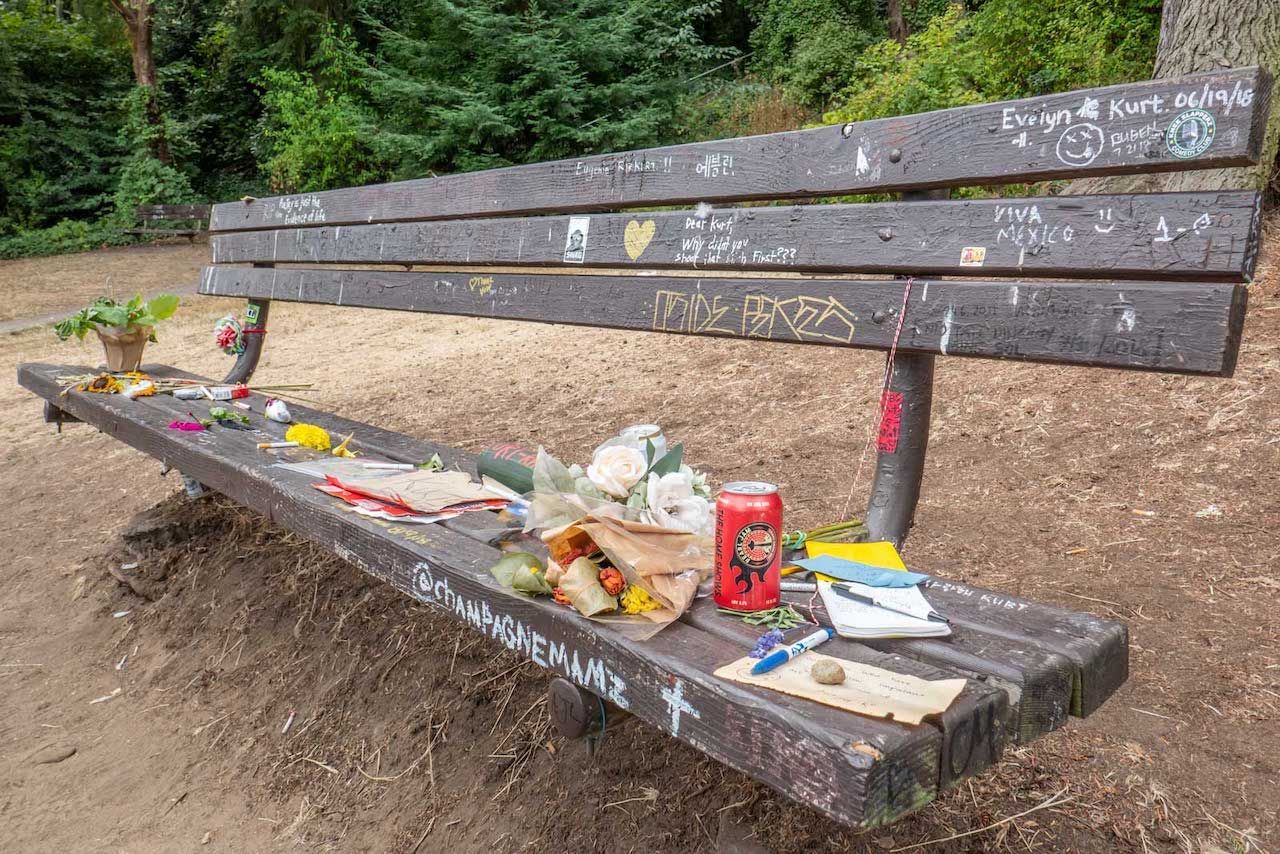
Photo: Brian Cicioni
Located next to the house that Kurt Cobain spent his final days in, Viretta Park has multiple benches covered with Nirvana-related graffiti. It’s a somber setting in an upscale neighborhood along Lake Washington. Fans leave gifts ranging from commonplace offerings like cigarettes and books to more eccentric items like bootleg CDs, booze, and other groceries.
Where: 151 Lake Washington Blvd. East
10. The Moore Theatre
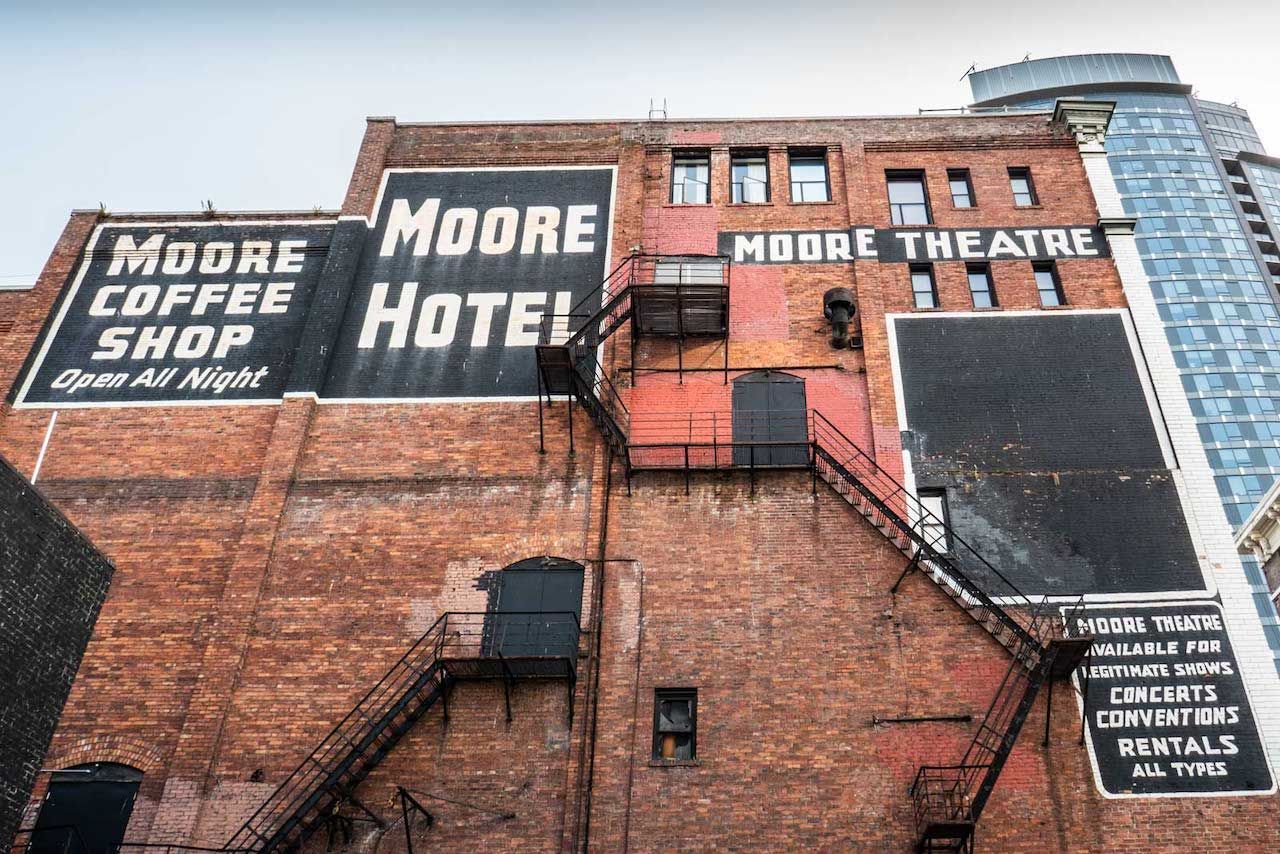
Photo: Brian Cicioni
Dating back to 1907, the Moore Theatre is the oldest Seattle theater still in use. Alice in Chains, Pearl Jam, and Soundgarden played there before they headlined arenas and stadiums. Some of the concert footage you see in Pearl Jam’s video for “Even Flow” was taken from a live performance at the Moore. Soundgarden recorded its 1988 “Fopp” EP here before signing with A&M. To see a healthier looking and more energetic Layne Staley, check out the Alice in Chains “Live Facelift” concert film from December 1990. Fewer than five years later, Mad Season (a Seattle supergroup fronted by Staley) recorded its only concert film, “Live at the Moore,” in the same venue. It proved to be their final show and Staley’s final performance in his home city. He died of an overdose in his University District condo fewer than seven years later.
Where: 1932 2nd Ave.
Nearest light rail station: Westlake
11. The Showbox

Photo: Brian Cicioni
The legendary Showbox dates back to 1939. Jazz legend Duke Ellington played here, as did blues guitarist Muddy Waters and The Ramones before their Seattle offsprings like Mudhoney, Pearl Jam, and Soundgarden made it a household name. In 2003, Pearl Jam released a limited edition DVD of its 2002 performance here called “Live at the Showbox.” The show is notable for the unveiling of the George W. Bush mask during “Bushleaguer,” as well as an Eddie Vedder anti-war improv at the end of “Daughter.” Both would make regular appearances during their 2003 world tour.
Where: 1426 1st Ave.
Nearest light rail station: University Street
12. Benaroya Hall

Photo: Brian Cicioni
Benaroya Hall is home to the Seattle Symphony. On October 22, 2003, Pearl Jam played a mostly acoustic show here to raise money for the Seattle-based charity YouthCare. It was released the following year on vinyl and as the two-CD set, “Live at Benaroya Hall.” The show marked the live debuts of “Man of the Hour,” the B-side “Fatal,” and a cover of Johnny Cash’s “25 Minutes to Go.”
Where: 200 University St.
Nearest light rail station: University Street
13. Screwdriver Bar
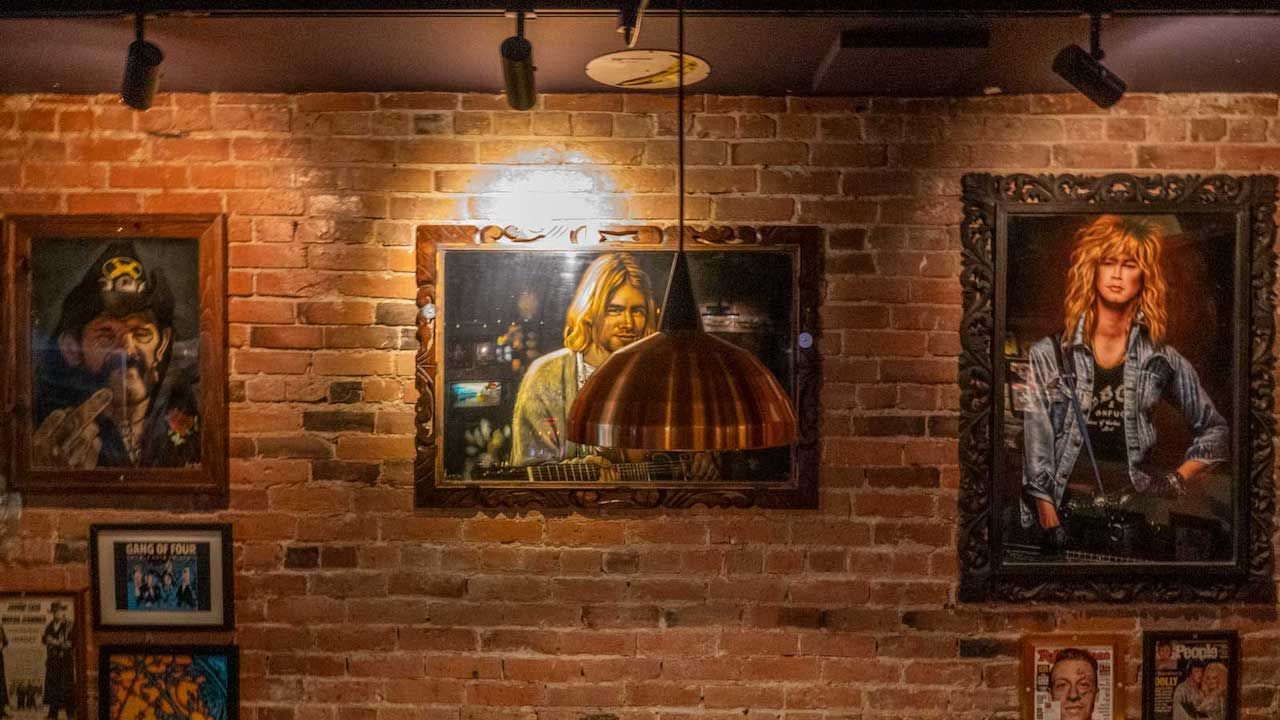
Photo: Brian Cicioni
This basement bar in Belltown served as Nirvana’s rehearsal space between “Bleach” and “Nevermind.” The three owners will proudly tell you that the last name on the lease before they took over was none other than Nirvana. Nowadays, the Screwdriver is a friendly neighborhood juke joint, which occasionally hosts live acts. The main barroom is like a rock and roll shrine of sorts. The walls are lined with images of rock icons from the 1960s to the present. They even have a Kiss pinball machine.
Where: 2320 1st. Ave
Nearest light rail station: Westlake
14. Easy Street Records

Photo: Brian Cicioni
Dating back to 1988, when CDs started to replace vinyl and cassette, Easy Street is an independent record store located in West Seattle. It also serves as a cafe and sometimes performance venue. This densely packed music store has hosted more than 500 in-store performances, and Pearl Jam released “Live at Easy Street,” an EP of their April 25, 2005, in-store performance.
Where: 4559 California Ave. Southwest
15. The Edgewater

Photo: Brian Cicioni
A innocent-looking picture of The Beatles fishing out of their second-floor room helped make The Edgewater the place to stay for visiting top acts in the latter half of the 1960s. Thanks to a July 1969 tale involving members of Led Zeppelin and Vanilla Fudge, a (naked) tied-up groupie, and a mud shark, the hotel along Elliot Bay is forever cemented in rock folklore. Only two bands have suites named in their honor at The Edgewater — one is The Beatles, and the other is Pearl Jam. Fifty years after the Edgewater became an iconic landmark for music fans and nearly 30 years after songs like “Jeremy,” “Even Flow,” and “Alive” were first heard around the world, Pearl Jam gets the same treatment in its home city as the most iconic rock band in world history.
If you can shell out at least $1,000 per night, you can stay in room 464 with your own guitar, Marshall amp, mini library, record player, and curated vinyl collection. As you enter the suite, you’ll see dozens of concert flyers from past Pearl Jam shows on your right. A replica of the famous Mother Love Bone mural hangs above the king-size bed while there are framed, hand-written setlists to the right. The bathroom wallpaper is an audience shot from an outdoor Pearl Jam show. Unlike the Beatles suite, the PJ suite has a balcony, offering panoramic views of Elliot Bay. Unfortunately, fishing from the balcony is no longer permitted.
Where: 2411 Alaskan Way
Nearest light rail station: Westlake
16. MoPOP (the former Experience Music Project)
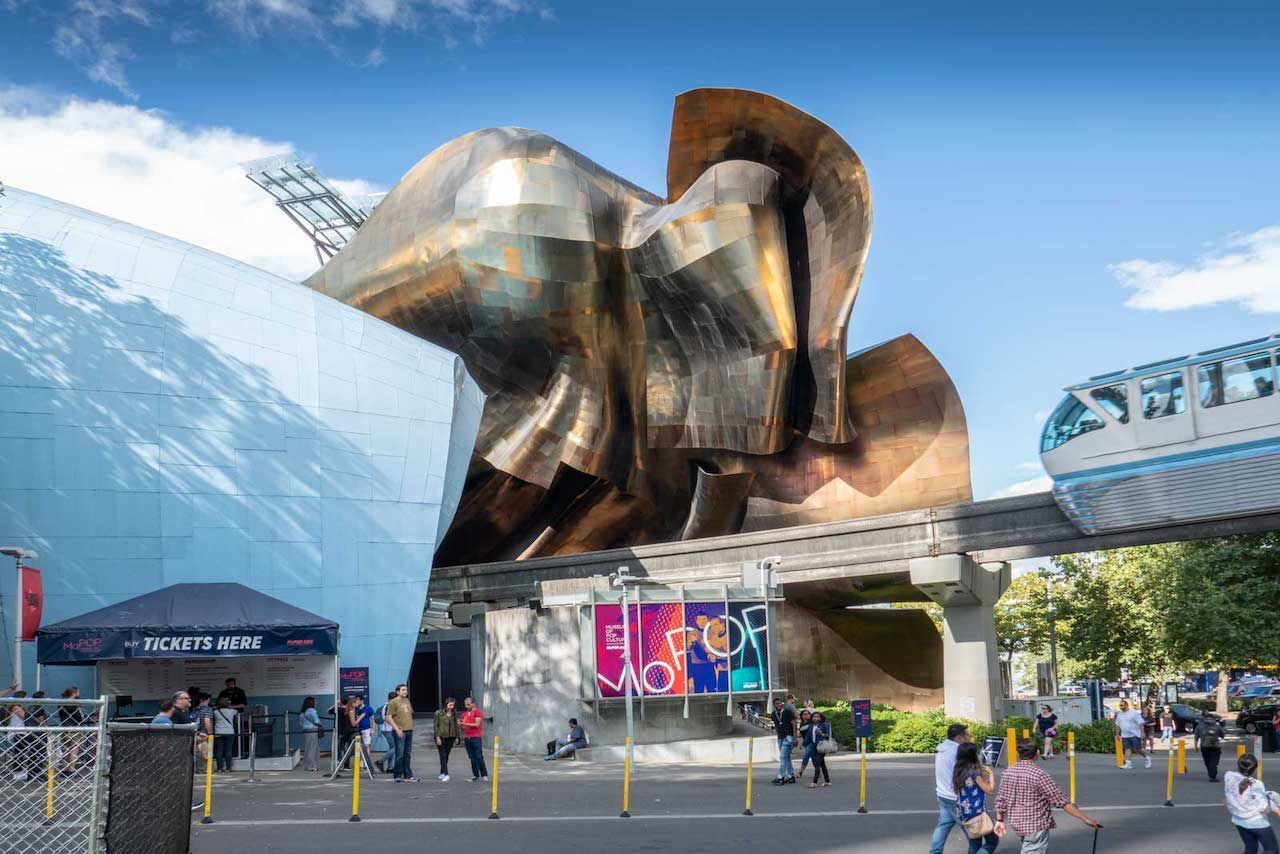
Photo: Brian Cicioni
In November 2016, the former Experience Music Project rebranded itself as the Museum of Pop Culture (MoPOP). The famous guitar sculpture is still there, and you can still play with an array of instruments on the second floor, but the 140,000-square-foot museum now focuses on film as well. The music exhibits still focus on artists from the Pacific Northwest. Current exhibits include “Nirvana: Taking Punk to the Masses” and “Pearl Jam Home and Away.”
The Nirvana exhibit is the smaller of the two and has interesting items like Kurt Cobain and Dale Crover’s first demo tape, as well as a map of where the “Seattle” bands actually came from. Tad is originally from Boise, Idaho! The exhibit also contains a typed-out setlist from Nirvana’s final show. The much larger Pearl Jam exhibit has enough band memorabilia to be a separate museum by itself. Most items are encased behind glass. They include Eddie Vedder’s George W. Bush mask from the 2003 tour, as well as Stone Gossard’s Devo costume from when Pearl Jam played the final show at the Philadelphia Spectrum on Halloween 2009.
Where: 325 5th Ave. North
Nearest light rail station: Seattle Center Monorail (connection from Westlake)